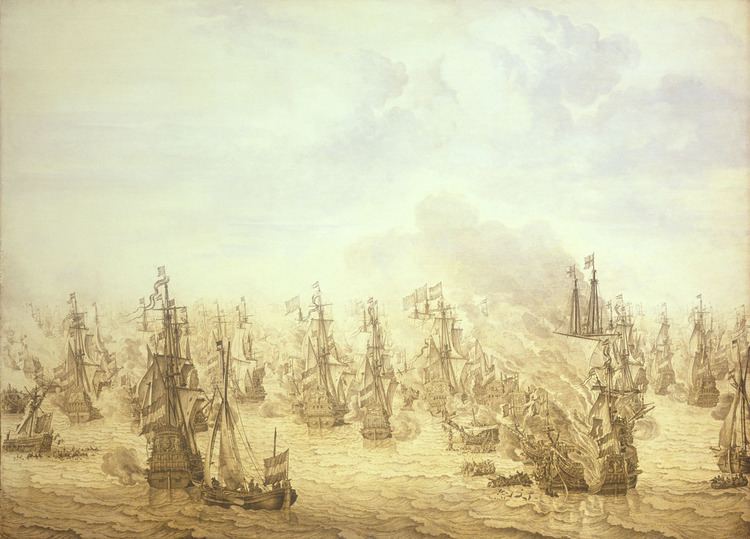Date 10 August 1653 | ||
 | ||
120 ships 100 ships under Tromp27 ships under De With 2 ships sunk,250 dead and 700 wounded 12-14 (Dutch claim)- 30 (English claim) ships captured or sunk,2000 taken prisoner or dead Results English tactical victory, Dutch strategic victory Similar First Anglo‑Dutch War, Battle of the Gabbard, Battle of Dungeness, Battle of Lowestoft, Battle of Leghorn | ||
01 trevor morris michiel de ruyter michiel is out there the battle of scheveningen
The Battle of Scheveningen (also known as the Battle of Texel or the Battle of Ter Heijde) was the final naval battle of the First Anglo-Dutch War. It took place on 31 July 1653 (10 August Gregorian calendar) between the fleets of the Commonwealth of England and the United Provinces, and had no clear victory.
Contents
- 01 trevor morris michiel de ruyter michiel is out there the battle of scheveningen
- Battle of scheveningen
- Background
- Battle
- Aftermath
- References
The name Battle of Texel may be questionable. There are two other known sea battles of that name (1673 and 1694), both fought near the island of Texel. However, Ter Heijde lies approximately 140 km south of Texel, which makes it unlikely that the reference to Texel is correct.
Battle of scheveningen
Background
After their victory at the Battle of the Gabbard in June 1653, the English fleet of 120 ships under General at Sea George Monck blockaded the Dutch coast, capturing many merchant vessels. The Dutch economy began to collapse immediately: mass unemployment and even starvation set in. On 24 July (3 August Gregorian calendar), Dutch Lieutenant-Admiral Maarten Tromp put to sea in the Brederode with a fleet of 100 ships to lift the blockade at the island of Texel, where Vice-Admiral Witte de With's 27 ships were trapped by the English. On 8 August, the English sighted Tromp and pursued to the south, sinking two Dutch ships before dark, but allowing De With to slip out and rendezvous the next day with Tromp off Scheveningen, right next to the small village of Ter Heijde, after Tromp had positioned himself by some brilliant manoeuvering to the north of the English fleet.
Battle
The winds were fierce on 30 July and overnight, giving both fleets pause. Around 7 in the morning of 31 July, the Dutch gained an advantage from the weather and attacked, led by the Brederode. The ensuing battle was ferocious, with both fleets moving through each other four times. Tromp was killed early in the fight by a sharpshooter in the rigging of William Penn's ship. His death was kept secret to keep up the morale of the Dutch, but by late afternoon, twelve of their ships had either been sunk or captured and many were too heavily damaged to continue the fight. In the end, morale broke and a large group of vessels under the command of merchant captains fled to the north. De With tried to halt their flight, but had to limit himself to covering the retreat to the island of Texel. However, the English fleet, also heavily damaged and with many wounded in urgent need of treatment, had to return to port to refit and were unable to maintain the blockade.
Aftermath
Both sides claimed a victory: the English because of their tactical superiority, the Dutch because the strategic goal of their attack, the lifting of the blockade, had been achieved. However, Tromp's death was a severe blow to the Dutch – few now expected to beat the English; the Orangist faction lost political influence and Grand Pensionary Johan de Witt was willing to give formal treaty assurances to Cromwell that the infant William III of Orange would never become stadtholder, thus turning the Netherlands into a base for a Stuart restoration. Peace negotiations began in earnest, leading to the 1654 Treaty of Westminster.
The damage done to the Dutch fleet effectively ended the first war. The Dutch capitulated to several English demands.
